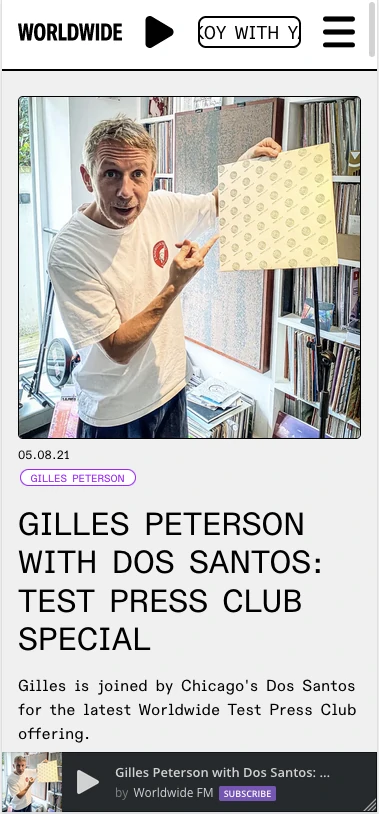WorldwideFM
Summary
A really fun project I was very excited to be involved with. In their own words WorldwideFM is: 'An award winning radio station with a global audience’. It's internet radio, and it's really good, you should check it out.
I was involved in this project in a development lead/architectural role, choosing frameworks and making technical decisions based on a spec brought forward by the client. In summary the time had come for them to upgrade their website, to support more features and enable the launch of a premium subscriber model.
 The WorldwideFM landing page
The WorldwideFM landing pageInternet radio is an interesting one, serving the actual audio stream is trivial with modern web APIs. The challenge is everything around it, giving the content editors an app that is fun and easy to work with, while also letting them serve interesting and varied content year on year. In such a content driven industry, there are also a heavy emphasis on taking SEO into account. Last but not least, we need to have an effortless way to navigate around the web app, without interrupting audio. Below I’ll separate out these three problems and how we tackled them.
Content management
Picking a CMS should mostly be about something that’s a joy to work with. The most important thing to remember is when a dev teams moves on, someone else’s job start, spending a significant part of their day creating content in the CMS.
For this project we picked Craft CMS. It did all the things we needed it to do, paid subscription support and a very good editing experience. As one of our mains priorities was to give something truly flexible to the client, we were keen on the https://craftcms.com/features/all#matrix matrix field systems in craft. It gives us a nice way of creating highly flexible content, that we can easily identify in a front end and style nicely, no matter the structure of the post.
 Listening back to a show on mobile
Listening back to a show on mobileEffortless navigation without interrupting audio
Modern SPA solutions are at their core for partially loading sites after the initial pageload, meaning we only swap out the part of the site we need to. This is a great match for solving issues around persisting parts of the site, meaning we can keep the header intact and not interrupt audio streams as the user navigates around.
We used Nuxt.js/Vue as our front end stack. This let’s us use vue-router to do client side SPA routing.
To fetch content from our CMS we use GraphQL, which works great in a scenario where the content is not coming from a custom API, but from a CMS, as it gives us a nice way of only fetching the content we need.
SEO
One of the main problems with javascript rendered applications have traditionally been a lack of indexing content with search engines, as its rendered in the browser after the initial page load. However, by running our front end on a node server, we can let Nuxt render the initial page on the server, send it down with all content in place, and let the browser take over responsibility from there. By doing this we can correctly set meta data, and search crawlers will see a fully rendered page, making the site receptible for organic search traffic.
Conclusion
With this approach we were able to deliver a site that is effortless both to maintain and visit. Which does not get in the way of letting the content shine.
